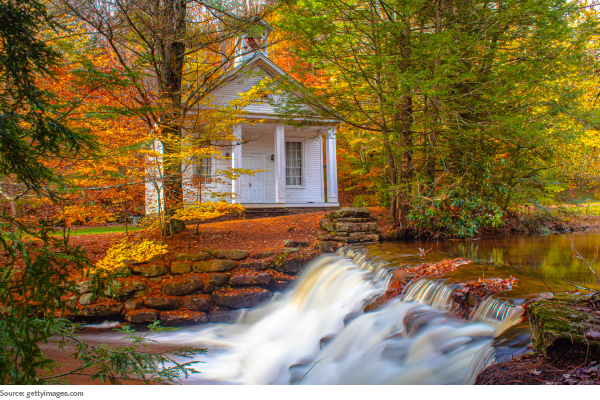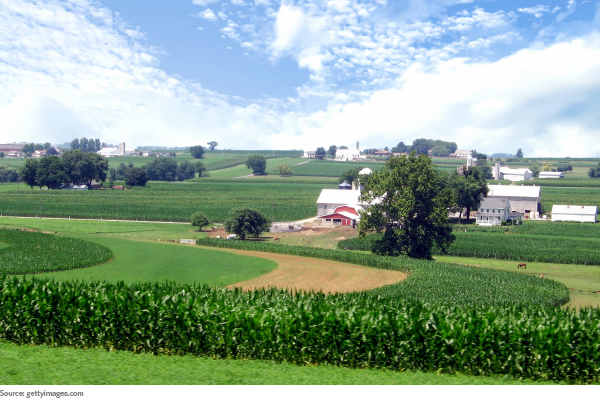U.S. News & World Report recently issued its list of the best places to retire in the U.S. in 2024.
The results may surprise you.
First, only one of the top 10 is in the Sunbelt. Florida, for example, dropped from previous years because of lower scores for happiness and desirability. Instead of warm beaches, the list reflected preferences for cultural and nature-related activities that active retirees might enjoy.
Second, many of the choices are in the Rust Belt—cities that were once hubs of industrial manufacturing and growth. Toward the end of the 20th century, however, their plants closed and the towns fell on hard times. In this century, these cities reinvented themselves and now offer numerous attractions and benefits as well as affordable housing.
Third, just two of the top 10 are big metropolitan areas. The rest are smaller cities, though many are within a short drive of major urban centers.
But perhaps the biggest surprise is that seven of the 10 top picks are in one state: Pennsylvania.
The selections were based on “the details people consider most carefully,” U.S. News said. It compared the 150 most populous urban areas of the country. The resulting preferences are based on a survey of people age 45 and older, weighed against objective data such as affordability, taxes, the local job market, and access to quality health care.
10. Pittsburgh
This major city is full of history. Once known for its dominant role in the steel industry—and sometimes still called “Steel City”—it’s also renowned for great natural beauty. Crisscrossed by rivers, including the Allegheny and Monongahela, it has more than 400 quaint bridges.
In addition, over the past three decades Pittsburgh—the second most populous city in Pennsylvania, after Philadelphia–began reinventing itself into a center for health care, education, and technology.
For instance, it’s home to Carnegie Mellon University and the University of Pittsburgh Medical Center.
Many corporations are headquartered there, and jobs are plentiful. “A rise in job opportunities has made Pittsburgh an attractive place for families and graduates,” said the U.S. News report. “Pittsburgh also offers a cheaper housing market than other large cities.”
The city’s diverse population has median income under $40,000 per family.
It’s also now know for some 2,000 acres of parks, several museums, sports venues, and the Phipps Conservatory and Botanical Gardens.

9. Youngstown, Ohio
Like Pittsburgh, Youngstown, Ohio, was once known for its dominant role in the steel industry. It is, after all, in the “Rust Belt” region, nestled in the foothills of the Appalachian Mountains. Yet it, too, has transformed itself.
“[It] is in the midst of a cultural and economic renaissance that combines rich historical tradition with the zeal of a new generation,” said U.S. News. “The area is seeing a resurgence of business in its once-empty downtown area, including restaurants, bars, galleries and local shops. … The downtown area is surrounded by farmland, and residents enjoy shopping at local farms and Amish markets.”
Roughly halfway between Pittsburgh and Cleveland, Youngstown has a diverse population with a median household income of $30,129, according to the 2020 census.
Also, the metropolitan area's violent- and property-crime rates were both lower than the national average.
As of September 2023, the median listing home price was $130,000, up nearly 23% year-over-year, as measured by the website realtor.com. So it’s become a somewhat trendy place to live.

8. Daytona Beach, Fla.
Daytona Beach, Fla., is the one Florida city still in the top 10. In fact, it’s the only Sunbelt city to make the list.
It has more than 23 miles of beaches open to pedestrians (though thong bikinis are prohibited). There are at least 10 waterfront parks. It also has multiple opportunities for people who like to golf or fish, according to U.S. News, and is home to the Daytona International Speedway, a mecca for NASCAR fans.
But Daytona Beach may stand out for its variety of other charms as well. “Life in Daytona Beach is balanced by museums, theaters, performing arts centers, antique markets, restaurants, malls and colleges that combine to make it one of Florida's most well-rounded metro areas,” said U.S. News.
Located on the Atlantic coast, it can get pummeled by tropical storms and hurricanes, however. Homeowners insurance has become so inexpensive that it’s out of reach for many residents.
Like any vibrant city with a diverse population and steady stream of visitors, especially in the winter months, Daytona Beach does have crime problem. But both violent crime and property crime were lower than the national averages, as of 2020.

7. York, Pa.
A historical city in the southern part of Pennsylvania, York was found back in 1741. Once the temporary home of the Continental Congress, it lays claim to being the birthplace of the Articles of Confederation and one of the first capitals of the U.S.
Today, it is full of museums and other places of interest. Many of its streets are narrow and cobblestoned—quaint for many residents and visitors, but difficult for those with mobility impairments.
The cost of living is estimated to be 4% lower than the national average, and housing is 14% cheaper than the national average.
With more than 40,000 residents, as of the last census, it is the 10th most populous city in the state. (Technically, Pennsylvania is a Commonwealth, not a state—along with Kentucky, Massachusetts, and Virginia.)
York’s population is diverse. In 1969, it was the site of a brutal race riot, but in the 21st century the city has been actively involved in extensive redevelopment efforts. In 2019, it elected its first African-American mayor, C. Kim Bracey. She held the position for the next eight years.
“York's shops, high-end apartments and special events–along with a flourishing arts community–have led to downtown living verging on trendy,” said U.S. News.

6. New York City
From the old city of York, Pa., the list moves north to the city of New York.
Known for its fast-paced energy and abundance of cultural activities, it also has one of the nation’s most extensive and accessible public transit systems (notwithstanding frequent complaints about broken elevators at subway stations). You don’t need to drive. Plus, New Yorkers over age 65 qualify for a reduced fare Metro Card.
The last census found that one in six New Yorkers is age 65 or older.
In addition, “the city that never sleeps” boasts some of the country’s best medical facilities and a vibrant service-oriented workforce (some pricier buildings even still have doormen).
Still, it is not the easiest place to live. The noise, crowds, and high costs are dealbreakers for many people. The city has a high sales tax and income tax rate. Housing in Manhattan costs an average of four times the national average. Other boroughs are cheaper, but there’s no denying that you need to be well-off to enjoy what NYC has to offer.

5. Allentown, Pa.
In the Lehigh Valley just south of the Blue Mountain range, Allentown is Pennsylvania’s third most populous city. (From here on, every city listed is in Pennsylvania.)
Located in the eastern part of the state, it is approximately an hour north of Philadelphia, for those who seek big-city cultural attractions. It also offers hikers and skiers a great variety of trails. “Allentown's convenient location, commitment to healthy living, and celebration of the arts make it a great place for active folks to live,” said U.S. News.
A former industrial town, its major industries in the 21st century are health care, technology, and energy. As of the last census, the median household income was about $66,000. The median home price was approximately $207,000, roughly 12% higher than the national average, while the cost of living was 5% below the national average.
Allentown is Pennsylvania’s fastest growing city.

4. Scranton, Pa.
In northeast Pennsylvania, Scranton is the state’s sixth most populous city. Known as an iron and steel juggernaut back in the 19th and 20th centuries, it still contains attractions such the Steamtown National Historic Site, with century-old locomotives set on a former rail yard. “But the close-knit neighborhoods that surround the vibrant downtown give Scranton its small-town appeal,” said U.S. News.
A low crime rate and low cost of living keep residents happy, too. Average cost of living is roughly 7% below the national average. Housing is some 24% cheaper than the national average.
In 2012, the city nearly went bankrupt. Since then, however, a revitalization effort has been attracting more people and businesses. The pedestrian-friendly downtown area created a vibrant nightlife. Empty old industrial buildings were converted to loft-style apartments.
It’s not as diverse as some growing cities. According to the last census, the population is 83% white. More than 20% of the population is age 65 or older.

3. Lancaster, Pa.
The state’s 11th most populous city, Lancaster boasts a diversity of people and interests.
“Expansive farms rub elbows with manicured suburbs, which lead right into the bustling city,” said U.S. News. “From close-knit church communities to the indie coffee shop scene, Lancaster holds something for everyone.”
There are natural wonders and commercial spaces within easy drive of each other. There are farmers, college students, young professionals, families, and retirees. Located in the center of the state, it is also considered the hub of Pennsylvania Dutch and Amish country.
Lancaster is some 61 miles west of Philadelphia. But you don’t need to go out of town to shop. Since 2005, Lancaster's downtown area has been revitalized with new boutiques, stores, clubs, and galleries.
Every September 27 is celebrated as Capital Day, a local holiday commemorating Lancaster's one and only day as capital of the United States in 1777.

2. Reading, Pa.
Reading (pronounced redding) has the fourth-largest population in Pennsylvania. Located in the southeast portion of the state, it is 63 miles northwest of Philadelphia.
In the 19th century, the city’s Reading Railroad was crucial to the transportation of anthracite coal from nearby mines to neighboring metropolitan markets along the East Coast. “People from all over the world were drawn to Reading by the promise of work in the thriving manufacturing and transportation industries,” said U.S. News. “As a result, the region's community is diverse.”
Since then, Reading fell on hard times. The 2010 U.S. Census found that it had the nation’s highest percentage of citizens living in poverty. Later surveys, though, showed steady improvement.
The cost of living is approximately 6% higher than the national average. Housing is roughly 4% more expensive than the national average, but utilities are some 13% below average.
The city has widespread public transit and two large hospitals. It is definitely on an upward trajectory.

1. Harrisburg, Pa.
Topping the list is Pennsylvania’s capital and ninth most populous city: Harrisburg.
Located about 100 miles northwest of Philadelphia, it’s had its share of financial difficulties in the past. Harrisburg was the first municipality ever charged with securities fraud by the SEC. The case was settled with a plea-bargain agreement in 2013.
Since then, it has gotten its economic house in order. In 2020, it boasted a capital surplus.
Today, the local economy includes more than 45,000 businesses, primarily in service-related industries such as health care, biotech, and technology. Many others are civil service jobs related to being a state capital. In addition, it’s a trade and distribution hub because of its extensive transportation infrastructure.
For retirees, it offers a variety of leisure pursuits. “Bikers and runners take in the scenery of the Susquehanna River on the trails of Riverfront Park, which also hosts many of the metro area's annual festivals and events,” said U.S. News. “Residents also enjoy hiking the famous Appalachian Trail or camping and mountain biking in the many nearby state parks and forests.”
Harrisburg has a high degree of racial diversity, and the cost of living is just 3% above the national average. It also offers good health care, low taxes for retirees, and “happy residents,” said U.S. News.









